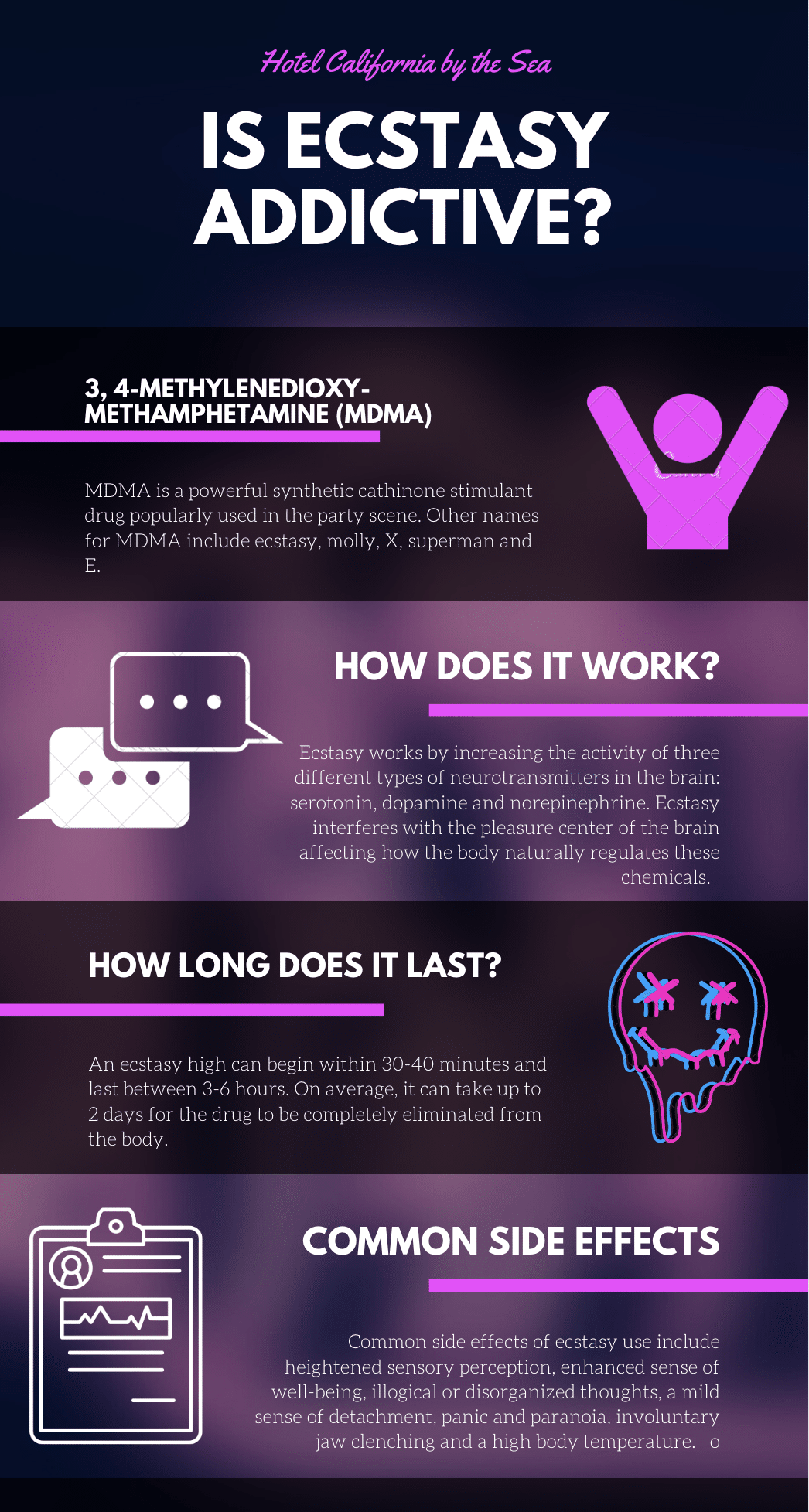Is Ecstasy Addictive?
Designer drugs have been associated with the party scene for decades. The drug 3,4-methylenedioxy-methamphetamine, also known as MDMA, continues to be a popular substance among young people and partygoers. MDMA is a synthetic substance that acts as a stimulant and hallucinogen producing feelings of high energy, distorted perception and enhanced sensory experiences. People often use MDMA for its enhanced feelings of alertness, euphoria and sensational physical effects. It is an empathogen that can increase feelings of empathy and kindness. It also causes users to feel increased longings of being social and connected to others.
Other names for the powerful designer cathinone stimulant include molly, m&m, ecstasy, X, E, superman, caps and XTC.

The drug was initially developed in the early 1900s as an appetite suppressant and a medication to control bleeding. But it quickly gained popularity in the 1980s as a club drug. In 1985, the DEA declared an emergency ban on MDMA and labeled it a Schedule I drug under the Controlled Substances Act. A Schedule I drug is a substance with no current accepted medical use and has a high potential for abuse. This makes it illegal to sell, use or buy.
According to the UN Office on Drugs and Crime, there are an estimated 9 million users of ecstasy worldwide. This group is mainly comprised of teens and young adults. In 2014, Global Drugs Survey found that over 20% of Americans used MDMA during the previous year. And in 2021, an estimated 0.8% of people ages 12 and older reported using MDMA in the previous year. Despite a slight decline in use, designer stimulant drugs such as MDMA continue to stay relevant among the younger generation.
Is Ecstasy Addictive?
MDMA works by increasing the activity of three different types of neurotransmitters in the brain: serotonin, dopamine and norepinephrine. These are often known as the “feel good” chemicals that our brain and body produce. The drug interferes with the brain’s pleasure center and affects the natural levels of chemicals, how much the body has and the body uses them.
The drug enhances the release of these neurotransmitters or blocks their reuptake. This results in more of the chemicals being available for the brain to use. It causes a surge of chemicals in the brain, which can cause a short-term depletion and can take weeks to naturally replenish. This results in cravings for the drug when the body is unable to naturally regulate itself.
Serotonin regulates mood, sleep, pain, appetite and other behaviors. Dopamine affects mood, memory, sleep, learning, concentration and body movements. Norepinephrine plays a role in regulating various cognitive functions, attention and stress reactions. When this trifecta of neurotransmitters is affected, it can cause an intense feeling of euphoria, heightened sensory experiences and long-lasting energy. Ecstasy enhances a user’s sense of sight, sound, smell and touch and produces lowered inhibitions.
An ecstasy high can begin within 30-40 minutes and last around 3-6 hours and can even go as long as 8 hours depending on varying factors and circumstances. It can take up to 2 days to be completely eliminated from the body.

Factors that affect how long MDMA can be effective
- Size, weight and health of the person
- Whether the person is accustomed to using the drug
- Whether or not other substances are also being used
- The amount of the drug that has been taken
- The strength and potency of the drug
- The environment in which the drug is taken
Over time, it produces a physical and psychological dependence and addiction. Not only can an addiction to MDMA develop, but an addiction to other substances as well. Research has found that 92% of ecstasy users are more likely to turn to other drugs such as amphetamines, cocaine and heroin. Polysubstance use is prevalent among ecstasy users and especially popular in the party scene.
Street tablets sold as ecstasy often contain other highly toxic additives. It is also frequently taken with other mind-altering substances including ephedrine, ketamine, cocaine, methamphetamine and other synthetic cathinones.
MDMA, ecstasy or molly is usually sold in capsules or colorful tablets. The colorful shapes make the drugs even more appealing to young adult users, making it easier for the drugs to be abused and for addiction to develop. However, recognizing an addiction to MDMA can be difficult. The drug lacks some of the more obvious withdrawal symptoms and is usually only used in social settings.
Check Your Insurance Coverage for FREE
Find out if your insurance covers addiction treatment in minutes. We accept most insurance!
Side Effects of Ecstasy
- Enhanced sense of well-being
- Increased extroversion
- Emotional warmth
- Emotionally charged
- Heightened sensory perception
- Increased positive sensations
- Increased capacity for empathy
- Unnatural long-lasting energy
- Inability to feel or a reduced sense of pain
- High blood pressure
- Faintness
- Panic and paranoia
- Seizures
- Involuntary jaw clenching
- Lack of appetite
- Mild sense of detachment from oneself
- Illogical or disorganized thoughts
- Nausea
- Hot flashes, excess sweating or chills
- Headache
- Sweating and high body temperature
- Muscle or joint stiffness
- Dehydration
- Changes in sleeping habits
- Impulsivity
Some of the long-term effects of Ecstasy addiction include the development of depression and anxiety, psychosis, memory loss and long-lasting brain damage. Long-term use can also cause harm to other aspects of the body including, nerve degeneration, kidney failure and cardiovascular conditions. The Journal Clinical Correlations reports that continued abuse of MDMA and other hallucinogenic stimulant substances can cause significant cognitive issues, and difficulty with executive processing, logical reasoning and emotional intelligence. It affects the overall mental functioning.
MDMA is a stimulant substance that affects the brain, heart and other major organs. It interferes with the body’s ability to regular body temperature. This can raise the heart rate to a dangerous level. In large doses of ecstasy, it could cause a person to feel floating sensations, out-of-character irrational behaviors, convulsions and even aggressive behaviors.
Indicators for an MDMA Use Disorder
- Noticeable changes in personality or behavior
- The inability to perform normal daily routines
- Strong urges or compulsions to use ecstasy or molly despite repeated negative effects
- New daily thoughts, routines and life revolve around ecstasy use
- Giving up commitments and responsibilities in order to use the drug
- Experience withdrawal symptoms once ecstasy use has been decreased or stopped completely
MDMA Withdrawal Timeline
- Days 1-3: Withdrawal symptoms can begin within a few days of quitting the drug. Symptoms can include anxiety, insomnia, inability to concentrate and feelings of paranoia. Feeling physical and mental exhaustion can also occur during the first few days of ecstasy withdrawal.
- Days 4-10: During this period, withdrawal symptoms may begin to lessen in severity.
- After 11 days: Onset depression can begin to take over the user’s brain chemistry as it continues to readjust. Cravings and memory impairments may continue and can last for weeks or even months after initial drug use.
Reach out to Hotel California by the Sea
We specialize in treating addiction and other co-occurring disorders, such as PTSD. Our Admissions specialists are available to walk you through the best options for treating your addiction.
Hotel California by the Sea offers effective substance use disorder programs to help people with stimulant hallucinogenic drug addiction. Designer drugs such as MDMA, LSD and bath salts are highly addictive substances that require the assistance of a professional behavioral health recovery program. A full range of treatments including detox, residential and outpatient programs provide clients with opportunities to successfully face their addiction.
Specialized treatments such as CBT, EMDR therapy and family counseling provide clients with evidence-based results. Hotel California by the Sea’s substance use disorder program provides the knowledge, tools and resources clients need to overcome their addiction and co-occurring mental health conditions.
References:
https://www.addictioncenter.com/drugs/ecstasy/
https://www.healthline.com/health/addiction/is-molly-addictive
